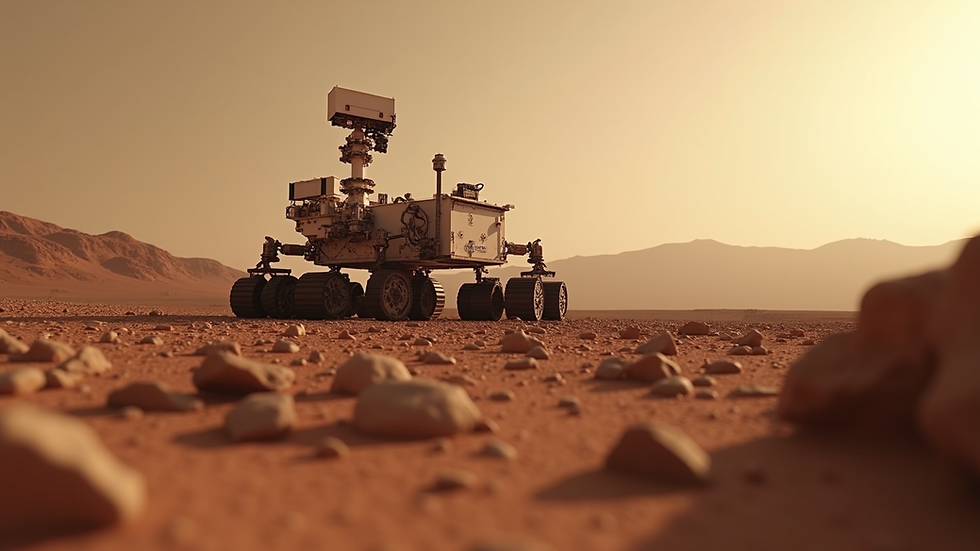Exploring the Intriguing Tales of Life on Mars
- Icarus

- Jun 16
- 4 min read
The concept of life on Mars has captivated humans for centuries. From ancient philosophers to modern scientists, the possibilities of Martian life have sparked imaginations and curiosity. As technology advances, we inch closer to unlocking the secrets of our planetary neighbor. But what exactly do we know about life on Mars? In this blog post, we will explore the intriguing tales that surround this red planet.
Life on Mars
Mars, often known as the "Red Planet," has been a subject of fascination due to its striking similarities to Earth. Scientists believe that Mars had liquid water on its surface billions of years ago. This raises an important question: Could it have supported life?
Recent discoveries have revealed signs of microbial life and other organic materials. The Mars rover missions, particularly the Perseverance rover, are equipped to seek out biosignatures that might indicate past life.

Moreover, the discovery of recurring slope lineae—dark streaks on Martian slopes—suggests that liquid saltwater may flow intermittently during warmer months. This adds to the belief that life could exist or may have once existed on the planet.
The Evolution of Martian Exploration
Martian exploration began in earnest in the 1960s, with missions such as NASA's Mariner program. These early missions provided the first close-up images of the Martian surface. However, it was the Viking landers in the 1970s that offered groundbreaking data on the planet’s soil and atmosphere.
Following those pioneering missions, a series of rovers including Spirit, Opportunity, and Curiosity have explored the Martian landscape. Each mission has provided valuable insights that have helped scientists piece together Mars' history.
The Perseverance rover, which landed in February 2021, marks the most ambitious effort to explore Mars. It is tasked with collecting samples that may eventually return to Earth for analysis.

The evolution of Martian exploration represents humanity's persistent quest to find answers about our universe. Each mission acts as a stepping stone towards uncovering more about life's potential beyond Earth.
The Search for Microbial Life
The core focus of Mars exploration is to search for signs of microbial life. If life ever existed on Mars, it is likely to have been microscopic.
One of the key areas of interest is Gale Crater, where the Curiosity rover has been analyzing sedimentary rocks. These rocks can reveal information about ancient environments that may have supported life. Additionally, the discovery of organic molecules in Martian soil has sparked excitement among scientists, suggesting that the building blocks of life may be present.
The Mars rover missions aim to analyze materials that could indicate past biological activity. These biosignatures include isotopic ratios and specific minerals that typically form in the presence of water.

The search for microbial life not only excites scientists but also the general public, which eagerly follows the latest findings and speculations surrounding the potential for life on Mars.
The Climate and Conditions on Mars
Understanding Mars' climate is essential in the quest for life. Mars has a thin atmosphere primarily composed of carbon dioxide, with only trace amounts of oxygen. Its surface pressure is less than one-tenth of Earth’s, posing challenges for living organisms.
Temperatures on Mars can vary significantly, ranging from -195°F (-125°C) during the winter at the poles to a balmy 70°F (20°C) at the equator during summer. These differences affect whether water exists in liquid form.
Despite these harsh conditions, some scientists theorize that extremophiles—organisms that can thrive in extreme environments—could survive on Mars. This raises questions about the possibility of life adapting to the planet’s extreme temperatures and radiation levels.
The Future of Mars Exploration
Looking ahead, plans for Mars exploration are becoming more ambitious. NASA aims to send humans to Mars by the 2030s, an ambitious project that could revolutionize our understanding of the planet and the potential for life.
SpaceX has also announced plans for manned missions to Mars, with ambitions to establish a human settlement. These efforts could open a new chapter in the exploration of life beyond Earth.
As our technological capabilities continue to advance, we are turning the pages of the great narrative of Mars’ history. New missions will help us gather data, analyze samples, and better understand the conditions necessary for supporting life.
In our quest, resources like the mars chronicles serve as valuable repositories of knowledge, enabling both scientists and enthusiasts to tap into the wonders of Martian exploration.
Envisioning Life on Mars
Currently, discussions surrounding life on Mars are largely speculative. However, envisioning what life forms could exist is an intriguing endeavor. If microbial life exists, it may take forms entirely different from what we know.
Moreover, scientists are exploring the possibility of synthetic life on Mars, especially regarding the future of human habitation. Creating ecosystems that can sustain human life or even genetically manipulating organisms to thrive in Martian conditions are areas of active research.
While the prospect of life on Mars generates excitement, it also presents ethical challenges regarding potential contamination of Martian ecosystems. As we push forward in our exploration, responsible practices must guide our endeavors.
The Call to Action
As we delve deeper into the mysteries of Mars, it is crucial for us to stay engaged and informed. The discoveries made in the coming years could reshape our understanding of life, the universe, and our place within it.
The unanswered questions surrounding Mars continue to provoke curiosity and inspire generations. Whether through education, advocacy for funding for space exploration, or even engaging in discussions about potential Martian life, we all play a part in shaping the future of interplanetary exploration.
Our journey from Earth to Mars tells a tale of human perseverance and the quest for knowledge. The mysteries of life on Mars are indeed rich with potential waiting to be unveiled as we continue to explore this incredible planet.
.png)



Comments